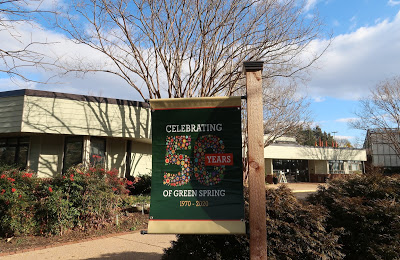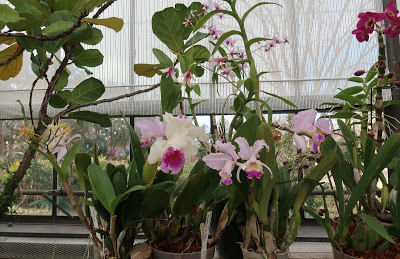Green Spring Gardens was created 50 years ago, thanks to a generous gift from a fascinating family
 |
| The horticultural center at Green Spring Gardens. |
In recognition of Green Spring Gardens’ 50th anniversary in 2020, the park is scheduling a series of events all year, including a big celebration in October.
The anniversary year kicked off Jan. 18 with a winter lecture about how the county acquired the land from the Straight family in 1970. The Straights were well-connected in the top rungs of society. Michael Straight had been a spy, a pilot trainer during World War II, and a senior government official. Belinda Straight was a psychiatrist and civil rights activist.
 |
| The Historic House was restored by the Straights. |
Plans for a big anniversary celebration on Oct. 24 haven’t been finalized, but there is likely to be a garden party featuring dignitaries, presentations, and the planting of a tree donated by Friends of Green Spring (FROGS), says Susan Eggerton, visitor services manager at Green Spring Gardens.
A couple of upcoming tea programs at the Historic House at Green Spring will focus on the 50-year theme, including one on “50 Years of Headlines,” looking at world and local news from the past half-century, on Feb. 9, and one on how women’s lives have been transformed over the past 50 years on March 22.
When the Garden Gate plant shop opens in April, there will be a 50-plant giveaway. Also in the works are plans for a moon gate somewhere in the park and several extra events during Fall Garden Day.
The Straights made Green Spring Gardens possible by donating their family home and surrounding land to the Fairfax County Park Authority in 1970, says Historic House coordinator Debbie Waugh at the Jan. 18 lecture.
The house was built in 1784. The Straights bought the house, outbuildings, and 32 acres of land in 1942 for $32,500. At the time, the area was mostly woods and dairy farms.
Michael’s mother, Dorothy Payne Whitney, was from one of the wealthiest families in the United States. His father, Willard Straight, died during the First World War when Michael was 3. His mother subsequently married an Englishman, Leonard Elmhirst, and they bought a huge manor house, Dartington Hall, which they transformed into an arts center and progressive school.
Michael married Belinda Crumpton in 1939. At the time, he was a speechwriter for President Franklin Roosevelt. They had been living in Alexandria, and when they saw the house at Green Spring, they “fell in love” with it, Waugh says.
 |
| The Historic House is used for tea programs featuring presentations on historical topics. |
The house needed significant work, however, so they brought in Walter Macomber, who had been the chief restoration architect at Colonial Williamsburg and Mount Vernon to renovate and expand it.
To create the gardens, the Straights hired Beatrix Farrand, a pre-eminent landscape designer who had designed Dumbarton Oaks in Georgetown. She created the boxwood hedge and stone wall in the garden behind the house.
During the time they lived at Green Spring, Michael Straight was the publisher of New Republic, the magazine founded by his parents, and served as chairman of the National Endowment for the Arts. The Straights entertained politicians, authors, and many prominent people, and raised five children, at Green Spring.
Michael had been offered a high-level government job, and faced with a background check, he revealed a long-held secret from his past: During his time at Trinity College in Cambridge, he was recruited as a spy and passed along information to the Soviets. He was granted immunity when his revelations led to the exposure of Anthony Blunt as the leader of the Cambridge Five spy ring.
Belinda also had a fascinating life. In 1945, she was one of few women to enroll in medical school. She worked as a psychiatrist at Children’s Hospital and had her own private practice, where she specialized in helping victims of sexual abuse.
She was also active in the civil rights movement. During Bloody Sunday, when police beat up protesters marching from Selma to Montgomery, Ala., in 1965, Belinda treated John Lewis, the future congressman, for a fractured skull.
By the mid-60s, the Straights decided to move away from Green Spring, as subdivisions were springing up around the area. In 1965, they purchased a house in Georgetown from Jackie Kennedy.
The Straights divorced not too long after that and had to think about what to do with the Green Spring property, Waugh says. Michael considered selling it to a developer, but they decided to preserve it as open space in the midst of suburban sprawl.
They sold a portion of the property, now occupied by car dealers on Little River Turnpike, and donated the remaining 18 acres to the county on the condition it would be preserved as a park.
 |
| Orchids in the glass house. |
Michael wrote several books, including “On Green Spring Farm” in 2002. He died in 2004. Belinda retired at age 87 and died in 2015. Her last visit to Green Spring was in 2012 for the dedication of a historic marker.
The Park Authority decided early on to create a horticultural park, Waugh says. The Park Authority removed an old barn, a log cabin, and a bridge over Turkeycock Run built by the Straights. Over the years, the county purchased surrounding land, and the park is now 31 acres.
Eventually, the Park Authority built the horticulture center, added the glass house, and created the demonstration gardens. The circular pathway was built in 1990. The house where the Straights lived was renovated for public use and is now known as the Historic House.
FROGS has contributed a huge amount of funding and volunteer support since it was founded in 1993. The horticulture center was replaced with a bigger one and the gazebo was built in 1995.
In 2001, Green Spring Gardens became the base for the county’s community horticulture program, which includes the rental garden plots, farmers markets, and master gardener program.
The Historic House was entered into the National Register of Historic Places in 2003, and in 2006, Green Spring’s witch hazel collection became part of the official Plant Collections Network. The Garden Club of Virginia restored the gardens in 2014, and last year, all the pathways were made compliant with the Americans with Disabilities Act.
Future plans for Green Spring include completion of a smart irrigation project funded by FROGS. Staff will no longer have to manually drag out hoses, Waugh says, and the new system will only send water when it’s needed and can be controlled remotely by a phone app.
Other possible improvements for the future include an outdoor classroom, creation of a meadow, and another expansion of the horticultural center.
The Straight’s gift has created a place “that enriches so many people, young and old,” Waugh says. “Green Spring will always be a cherished place.”


Really cool history, thanks Ellie
Love this place. Have painted and exhibited there, too.
This is a nice piece. I love it.
Leonard Garment, Counselor to President Richard Nixon, lived in this house in the early 1970s, he must have rented it from Fairfax County Parks Authority? I used to play after school on the grounds with his children and overnighted a couple of times in the old house, it was very beautiful. There were special red "hotline" phones on each floor that we kids were forbidden to touch — apparently direct lines to the White House operator. I do recall the phone ringing late at night, and Mr. Garment must have picked it up.